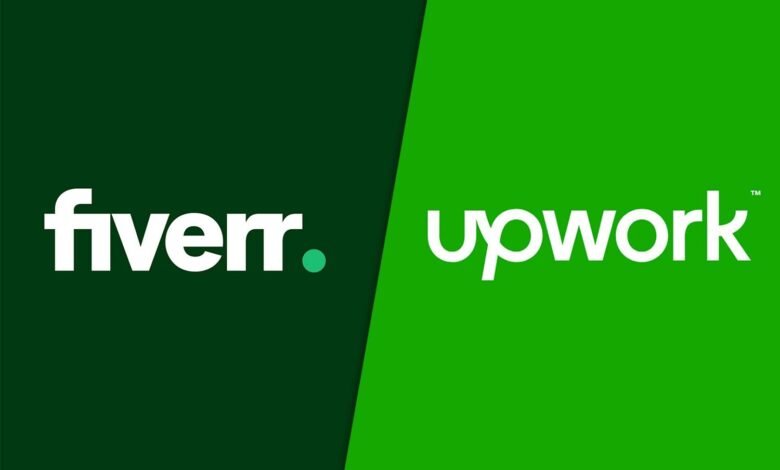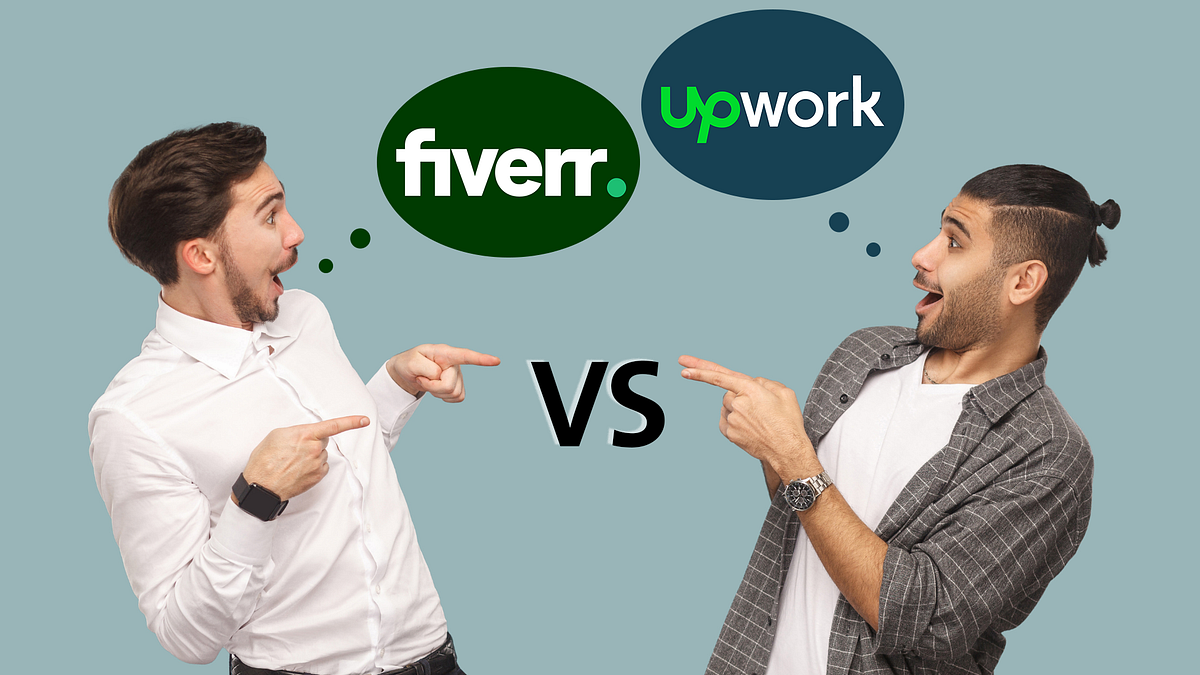Upwork vs Fiverr Which Freelance Platform is Better for You
Compare Upwork vs Fiverr features, fees, and benefits. Discover which freelance platform suits your needs better for hiring talent or finding work

The freelance economy has transformed how businesses operate and professionals work, with millions of individuals choosing remote work over traditional employment. Among the countless freelance platforms available today, Upwork and Fiverr stand out as the two most prominent marketplaces connecting clients with talented freelancers across the globe. Whether you’re a business owner seeking skilled professionals or a freelancer looking to build your career, choosing between these two platforms can significantly impact your success and earnings.
Both Upwork vs Fiverr offer unique advantages, but they operate on fundamentally different models. Upwork positions itself as a comprehensive marketplace for long-term projects and ongoing relationships, where clients post detailed job descriptions and freelancers submit proposals. In contrast, Fiverr operates on a service-based model where freelancers create predefined service packages called “gigs” that clients can purchase directly. This fundamental difference influences everything from pricing structures to the types of projects available on each platform.
Which freelancing platform aligns with your goals requires analyzing multiple factors, including fee structures, project types, payment methods, user experience, and earning potential. For businesses, the right choice depends on project complexity, budget constraints, and the desired level of involvement in the hiring process. For freelancers, success factors include service offerings, pricing strategies, and preferred working relationships with clients.
The decision between Upwork and Fiverr isn’t always straightforward. Many successful freelancers maintain profiles on both platforms to diversify their income streams, while businesses often use different platforms for different project types. This comprehensive comparison will examine every aspect of both platforms, from registration processes to payment systems, helping you make an informed decision based on your specific needs. Whether you’re seeking to hire freelancers for your business or establish yourself as an independent professional, understanding the nuances of each platform is crucial for maximizing your return on investment and achieving your professional objectives in the competitive gig economy of 2025.
Upwork: The Comprehensive Freelance Marketplace
What is Upwork
Upwork is the world’s largest freelance marketplace, connecting over 18 million registered freelancers with businesses seeking professional services. Formerly known as Elance-oDesk before its rebranding in 2015, Upwork has established itself as the premier platform for finding skilled professionals across virtually every industry. The platform facilitates billions of dollars in annual transactions, making it a powerhouse in the freelance platform ecosystem.
The Upwork platform operates on a proposal-based system where clients post detailed job descriptions, and freelancers submit customized proposals outlining their qualifications, approach, and pricing. This model gives clients complete control over the selection process, allowing them to review portfolios, conduct interviews, and negotiate terms before committing to a hire. The platform supports both hourly and fixed-price contracts, accommodating projects ranging from short-term tasks to long-term engagements spanning months or even years.
Key Features of Upwork
Upwork’s features are designed to support complex projects and ongoing business relationships. The platform offers advanced search filters that allow clients to find freelancers based on skills, experience level, hourly rates, location, and previous work history. The built-in messaging system facilitates seamless communication, while the time-tracking software provides transparency for hourly projects.
One standout feature is Upwork’s escrow payment system, which protects both parties by holding funds until work is completed satisfactorily. For hourly contracts, the Work Diary feature captures screenshots and activity levels, ensuring accountability. Upwork also offers talent badges, Top Rated status, and Rising Talent designations that help high-performing freelancers stand out in a competitive marketplace.
The platform’s enterprise solutions cater to larger organizations with features like dedicated account management, curated talent pools, and advanced reporting capabilities. Upwork Pro connects businesses with pre-vetted, highly skilled freelancers who have passed rigorous screening processes, though at premium rates.
Upwork Fee Structure
Understanding Upwork fees is crucial for both clients and freelancers. Freelancers pay a sliding service fee based on their lifetime billings with each client. The fee structure operates on a tiered system: 20% for the first $500 billed to a specific client, 10% for lifetime billings between $500.01 and $10,000, and 5% for billings exceeding $10,000 with that client.
For clients, Upwork charges a 5% payment processing fee on top of the agreed project cost. While this might seem significant, it covers payment processing, dispute resolution, and platform maintenance. Clients can also purchase Connects to boost their job postings, though this is optional.
The tiered fee structure benefits freelancers who establish long-term relationships with clients, as their effective commission rate decreases substantially over time. This incentivizes quality work and client retention, aligning with Upwork’s focus on sustainable business relationships rather than one-off transactions.
Fiverr: The Gig-Based Service Marketplace
What is Fiverr
Fiverr revolutionized the freelancing landscape when it launched in 2010 with a simple premise: all services start at five dollars. While pricing has since evolved significantly, the platform retains its user-friendly approach to buying and selling services. With over 4 million active buyers and millions of freelancers offering services, Fiverr has become the go-to platform for quick, straightforward projects.
Unlike traditional freelance marketplaces, Fiverr operates on a reverse model where freelancers create service listings called “gigs” that describe exactly what they offer, at what price, and within what timeframe. Clients browse these pre-packaged services, select what they need, and purchase directly without lengthy negotiation processes. This streamlined approach makes Fiverr particularly attractive for clients who know exactly what they want and prefer transparent, upfront pricing.
Key Features of Fiverr
Fiverr’s platform excels in simplicity and speed. Freelancers, known as “sellers” on Fiverr, create gigs with clear descriptions, pricing tiers (Basic, Standard, and Premium), delivery times, and included revisions. High-quality gig images and videos help sellers showcase their work and attract buyers.
The platform’s leveling system rewards consistent performers with better visibility and additional features. Sellers progress from New Seller to Level One, Level Two, and ultimately Top Rated Seller status based on performance metrics, including order completion, response time, and customer ratings. Each level unlocks benefits like priority customer support and the ability to offer more gigs.
Fiverr Pro represents the platform’s premium tier, featuring thoroughly vetted professionals who have demonstrated exceptional skills and professional experience. Pro services command significantly higher prices but come with quality guarantees and dedicated support. The platform also offers Fiverr Business, an enterprise solution providing managed services for larger organizations.
Additional features include Fiverr Learn, which offers courses for skill development; Fiverr Workspace for project management; and Seller Plus, a subscription service providing additional promotional tools and analytics for serious sellers.
Fiverr Fee Structure
Fiverr’s fee structure is straightforward but less flexible than Upwork’s. Sellers pay a flat 20% commission on all earnings, regardless of order size or client relationship duration. This simplicity makes income calculations predictable, but can be expensive for high-value projects where percentage-based fees become substantial.
Buyers on Fiverr pay a service fee of $2 on purchases up to $40, and 5% on purchases above $40. This fee structure makes smaller projects relatively more expensive for buyers, but becomes more competitive on larger orders. All fees are clearly displayed before purchase, eliminating surprises.
Sellers also face withdrawal fees depending on their chosen payment method. While some options like Fiverr Revenue Card offer fee-free withdrawals, methods like PayPal or bank transfers may incur additional charges ranging from $1 to $3 or percentage-based fees.
Upwork vs Fiverr: Direct Comparison

Project Types and Complexity
The fundamental difference in Upwork vs Fiverr lies in project types and complexity. Upwork specializes in complex, long-term projects requiring extensive collaboration. The platform attracts clients seeking dedicated team members for ongoing work, whether that’s a full-time virtual assistant, a developer for a six-month software project, or a marketing consultant for quarterly campaigns.
The proposal system on Upwork accommodates custom requirements and allows freelancers to ask clarifying questions before committing. This makes it ideal for projects where the scope isn’t fully defined upfront or where the client’s needs might evolve. Hourly contracts provide flexibility for open-ended work, while milestone-based payments work well for defined deliverables within longer engagements.
Fiverr excels with quick turnaround projects that have clear deliverables. Logo design, blog post writing, social media graphics, video editing, and voice-overs are perfect for Fiverr’s model. The predefined service packages eliminate negotiation time, making it possible to start work within minutes of placing an order. This speed and simplicity appeal to businesses needing specific tasks completed quickly without ongoing management.
Pricing and Budget Considerations
Pricing structures reveal another crucial distinction between these freelance platforms. On Upwork, pricing is negotiable and varies widely based on freelancer experience, project complexity, and market rates. Clients can find freelancers at virtually any price point, from $10 per hour for basic tasks to $200+ per hour for specialized expertise.
The Upwork pricing model benefits clients with flexible budgets who value quality and expertise over cost. The sliding fee structure also rewards both parties who maintain long-term relationships, with freelancer commissions dropping to as low as 5% after billing $10,000 to a single client.
Fiverr’s pricing is transparent and standardized through gig packages. Most gigs offer three tiers: Basic (entry-level service), Standard (enhanced features), and Premium (comprehensive solution). This structure helps clients understand exactly what they’re purchasing and at what cost. While this transparency is valuable, it can sometimes limit flexibility for unique requirements.
Budget-conscious clients often find Fiverr more accessible for small projects, with many quality services available between $20-$100. However, premium services and specialized expertise on Fiverr can command prices comparable to or exceeding Upwork rates, especially at the Pro level.
Quality and Vetting Process
Quality control differs significantly between platforms. Upwork relies primarily on client reviews, work history, and self-reported skills. While the platform offers skill tests and certification programs, there’s no mandatory vetting before freelancers can start bidding on projects. The Top Rated and Expert-Vetted badges help identify proven performers, but clients must conduct their own due diligence.
Upwork Pro addresses quality concerns by pre-screening freelancers through rigorous evaluation processes, but these premium services command higher rates. The platform’s detailed freelancer profiles, including work history, earnings, job success scores, and client feedback, provide substantial data for informed hiring decisions.
Fiverr’s quality depends heavily on its rating system and seller levels. The platform’s algorithm promotes high-performing sellers with consistent five-star reviews, fast response times, and reliable delivery. However, new sellers without established reputations may struggle to compete, regardless of their actual skill level.
Fiverr Pro represents the platform’s answer to quality concerns, featuring hand-vetted professionals with proven track records. While Pro services cost significantly more, they come with quality assurances and priority support. The clear distinction between regular and Pro services helps clients make informed choices based on their quality requirements and budget.
User Experience and Interface
The user experience on Upwork caters to clients who are comfortable with active project management. Posting a job requires detailed descriptions, budgets, and preferred freelancer qualifications. Reviewing proposals, conducting interviews, and managing contracts demands time investment. However, this thoroughness enables better matching and reduces misunderstandings.
For freelancers, Upwork’s interface requires building comprehensive profiles, writing customized proposals for each job, and maintaining good communication throughout the bidding process. The Connect system, which requires spending Connects to submit proposals, adds another layer of strategy to the freelancer experience.
Fiverr’s user experience prioritizes simplicity and speed. Clients browse services like shopping on an e-commerce site, filtering by category, price, delivery time, and seller rating. The ability to immediately purchase and start a project makes Fiverr exceptionally user-friendly for straightforward needs. The order page clearly outlines deliverables, timelines, and revision policies, minimizing confusion.
For sellers, Fiverr requires creating attractive gigs with compelling descriptions and visuals. Unlike Upwork’s proposal-based system, Fiverr sellers wait for orders to arrive based on their gig visibility and appeal. Success depends on optimizing gig SEO, accumulating positive reviews, and maintaining excellent metrics to climb the seller levels.
For Freelancers: Which Platform is Better
Building Your Freelance Career on Upwork
Freelancers on Upwork have opportunities to build substantial, sustainable businesses through long-term client relationships. The platform’s structure rewards specialization, expertise, and professionalism. Freelancers who invest time in creating comprehensive profiles, obtaining certifications, and delivering exceptional work can command premium rates and secure ongoing contracts.
The Upwork ecosystem particularly benefits professionals offering services that require consultation, customization, or ongoing collaboration. Developers, project managers, business consultants, content strategists, and marketing specialists often thrive on Upwork because their services align with the platform’s project-based model. The ability to negotiate rates and terms also appeals to experienced professionals who understand their value.
However, succeeding on Upwork requires patience and persistence. New freelancers face intense competition and must strategically use their limited Connects to bid on suitable projects. Building a strong profile with positive reviews takes time, and the initial 20% fee can feel steep before establishing long-term client relationships that reduce the commission to more reasonable levels.
Building Your Freelance Career on Fiverr
Fiverr freelancers benefit from the platform’s massive buyer traffic and simplified transaction process. Sellers who create compelling gigs, optimize for Fiverr’s search algorithm, and consistently deliver quality work can build thriving businesses. The leveling system provides clear milestones and incentives for maintaining excellent performance metrics.
Fiverr works best for freelancers offering standardized services with clear deliverables. Graphic designers, video editors, voice-over artists, translators, and writers providing specific content types often excel on Fiverr. The ability to sell the same service repeatedly to different buyers creates efficiency that can lead to high earnings relative to time invested.
The 20% commission on Fiverr remains constant regardless of order size or client relationship, which can be disadvantageous for high-value projects. However, the platform’s focus on quick turnaround and repeat buyers means successful sellers can build significant volume, offsetting the higher commission percentage. The passive nature of gig sales also allows sellers to earn while focusing on delivery rather than constantly bidding on new projects.
Income Potential Comparison
Earning potential on both platforms varies dramatically based on skills, experience, and work approach. Top freelancers on Upwork can earn six-figure annual incomes by securing long-term contracts with multiple clients. The decreasing fee structure means experienced freelancers retain more of their earnings as relationships mature.
High-performing sellers on Fiverr also achieve substantial incomes, particularly those who scale by offering multiple gigs, upselling premium packages, and maintaining high order volumes. Fiverr’s top sellers report monthly earnings exceeding $10,000, though reaching these levels requires exceptional quality, marketing savvy, and operational efficiency.
For beginners, Fiverr often provides faster initial earnings since gigs can start receiving orders immediately once published. Upwork typically requires more time to establish credibility and win first contracts, but the potential for higher individual project values can compensate for slower starts.
For Clients Which Platform is Better

Hiring on Upwork for Business Needs
Businesses using Upwork gain access to a vast talent pool capable of handling complex, specialized projects. The proposal system allows comparing multiple candidates’ approaches, experience, and pricing before making hiring decisions. This thoroughness is invaluable for critical projects where the wrong hire could be costly.
Upwork’s platform excels for businesses seeking team members for extended periods. Companies can hire virtual assistants, dedicated developers, ongoing content creators, or specialized consultants for projects spanning months. The time-tracking and reporting features provide transparency and accountability for hourly contracts.
The Upwork payment protection system ensures funds are secure, while the dispute resolution process provides recourse if projects go wrong. For businesses prioritizing quality and willing to invest time in the hiring process, Upwork offers unmatched flexibility and talent diversity.
Hiring on Fiverr for Business Needs
Fiverr serves businesses needing specific deliverables quickly without extensive management overhead. The pre-packaged gig structure eliminates negotiation time and provides clear expectations upfront. Businesses can order logo designs, product descriptions, marketing videos, or other defined services and receive completed work within days.
The transparent pricing on Fiverr helps businesses budget accurately for projects. Knowing exactly what’s included in each package tier prevents scope creep and unexpected costs. For companies with multiple small projects, Fiverr offers efficiency that traditional freelancing platforms can’t match.
Fiverr particularly appeals to startups, small businesses, and entrepreneurs who need professional services but lack time for extensive freelancer vetting and project management. The rating system and seller level badges provide quick quality indicators, while the platform’s buyer protection policies ensure satisfaction or refunds.
Payment Methods and Security
Upwork Payment System
Upwork’s payment system provides security for both clients and freelancers through its escrow-based model. Clients fund their accounts before hiring, ensuring freelancers get paid for completed work. For hourly contracts, the weekly billing cycle automatically charges clients for approved hours, with funds released to freelancers after a short security period.
Freelancers on Upwork can withdraw earnings via direct deposit, wire transfer, PayPal, Payoneer, or M-Pesa in supported regions. Payment processing times vary by method, with direct deposits typically arriving within days. The platform holds funds for 10 days after billing to allow time for client disputes, after which freelancers can withdraw their earnings.
Upwork’s dispute resolution process addresses conflicts between clients and freelancers. The platform reviews evidence from both parties and makes binding decisions on payment disputes. This system, while not perfect, provides recourse when projects face problems.
Fiverr Payment System
Fiverr’s payment structure prioritizes buyer security by holding payments until order completion. When buyers purchase a gig, Fiverr holds the funds and only releases them to sellers after order delivery and buyer approval, or after a 14-day clearance period if no issues are raised.
Sellers on Fiverr can withdraw earnings once the clearance period passes and they reach the minimum withdrawal threshold. Available withdrawal methods include PayPal, bank transfer, Fiverr Revenue Card, and Payoneer. Processing times and fees vary by method, with some options offering instant access to funds while others take several business days.
The Fiverr resolution center handles disputes through a structured process. Buyers can request modifications if deliverables don’t meet expectations, or request cancellations with refunds if sellers fail to deliver. The platform’s algorithms monitor seller performance, and repeated issues can result in account penalties or restrictions.
Customer Support and Dispute Resolution
Upwork Support System
Upwork provides customer support through multiple channels, including help center articles, community forums, and direct support tickets. The comprehensiveness of support varies based on user status, with Top Rated freelancers and enterprise clients receiving priority assistance. Response times can range from hours to days, depending on issue complexity and volume.
The Upwork Help Center contains extensive documentation covering common questions, platform features, and best practices. Community forums allow users to seek advice from experienced freelancers and clients, often providing faster resolutions for simple issues than waiting for official support.
For serious disputes, Upwork’s mediation process involves platform representatives reviewing evidence and making decisions. The escrow system provides a framework for resolution, with funds held or released based on investigation outcomes. While the process isn’t always perfect, it offers structured recourse when conflicts arise.
Fiverr Support System
Fiverr’s customer support has evolved significantly, offering 24/7 assistance through various channels. Basic support is available to all users via help center articles and support tickets. Sellers at higher levels and Fiverr Pro members receive priority support with faster response times and dedicated representatives.
The Fiverr Resolution Center provides structured processes for handling order issues. Buyers can request revisions, extensions, or cancellations directly through the platform. Sellers can accept, decline, or propose alternatives to requests. If users can’t resolve issues independently, Fiverr support intervenes to mediate.
Fiverr’s commitment to user satisfaction includes policies protecting both buyers and sellers. Buyers receive refunds for undelivered orders or work significantly deviating from descriptions. Sellers are protected against unfair cancellation requests and receive compensation for completed work meeting specified requirements.
Success Tips for Each Platform

Maximizing Success on Upwork
Succeeding on Upwork requires strategic profile optimization. Create comprehensive profiles highlighting relevant experience, skills, and portfolio pieces. Invest time in skill tests and certifications to validate expertise. Build a professional profile image and craft compelling overview statements that differentiate you from competitors.
Writing winning proposals is crucial for Upwork success. Customize each proposal to the specific job, addressing client needs directly. Demonstrate understanding of project requirements, outline your approach, and explain why you’re the ideal candidate. Avoid generic templates that fail to connect with clients’ unique situations.
Upwork freelancers should strategically bid on projects matching their expertise and budget expectations. Starting with smaller projects to build reviews makes sense for newcomers, but don’t undersell your skills significantly just to win jobs. Maintain professional communication, meet deadlines consistently, and exceed expectations to earn positive reviews and higher job success scores.
Building long-term relationships on Upwork maximizes earnings through reduced fees and stable income. Deliver exceptional work that makes clients eager to rehire you. Communicate proactively, suggest improvements, and position yourself as a trusted partner rather than just a service provider.
Maximizing Success on Fiverr
Fiverr success begins with creating outstanding gigs. Invest in high-quality gig images or videos that showcase your work professionally. Write clear, benefit-focused descriptions that explain exactly what buyers receive. Structure pricing tiers strategically, offering real value at each level while encouraging upgrades to premium packages.
Optimizing for Fiverr’s search algorithm increases gig visibility. Use relevant keywords in titles, descriptions, and tags. Research successful competitors to understand what works in your category. Update gigs regularly to maintain algorithmic favorability and reflect your evolving skills.
Fiverr sellers must maintain excellent performance metrics to climb seller levels. Respond to messages within hours, deliver orders on time or early, and maintain high customer satisfaction ratings. Each level unlocks additional benefits that compound over time, making consistent performance crucial for long-term success.
Marketing your Fiverr gigs outside the platform can accelerate growth. Share gigs on social media, include links in email signatures, and leverage personal networks. Building an external audience that directs buyers to your gigs bypasses some initial visibility challenges new sellers face.
Pros and Cons Summary
Upwork Advantages and Disadvantages
Upwork’s advantages include access to high-value, long-term projects; opportunities to build substantial client relationships; a decreasing fee structure benefiting experienced freelancers; flexible pricing negotiations; and comprehensive platform tools supporting complex projects. The platform’s scale provides steady project flow in virtually every professional category.
Disadvantages of Upwork include intense competition, making it difficult for beginners; the Connect system requiring strategic bid spending; higher initial fees before building client relationships; time-intensive proposal writing; and variable client quality requiring careful vetting. The platform’s complexity can be overwhelming for users seeking simple, quick transactions.
Fiverr Advantages and Disadvantages
Fiverr’s advantages include simple, fast transactions; transparent, upfront pricing; high platform traffic providing consistent buyer flow; straightforward seller leveling system with clear progression; and lower barriers to entry for new freelancers. The gig-based model allows creating passive income streams once gigs gain visibility and reviews.
Disadvantages of Fiverr include the flat 20% commission on all earnings; limited pricing flexibility; challenges building direct client relationships; intense competition in popular categories; and the algorithm’s sensitivity to metrics,m eaning a few negative reviews can significantly impact visibility. The platform’s focus on quick projects may not suit freelancers preferring deep, ongoing collaborations.
Alternative Freelance Platforms
Other Platforms Worth Considering
Beyond Upwork and Fiverr, several alternative freelancing platforms serve specific niches or offer different approaches. Toptal positions itself as an elite marketplace connecting businesses with the top 3% of freelance talent after rigorous screening. Rates are premium, but so is quality assurance.
Freelancer.com operates similarly to Upwork with project-based bidding and fixed-price contests. The platform offers global reach and competitive pricing, though some users report higher instances of low-quality proposals. Guru provides another alternative with a focus on long-term working relationships and flexible payment options.
PeoplePerHour caters particularly to European markets with a hybrid model combining job postings and service packages. 99designs specializes exclusively in design work with contest-based and traditional hiring options. Catalant focuses on high-end consulting engagements for enterprise clients.
Industry-specific platforms like Dribbble and Behance for designers, GitHub for developers, or Contently for writers offer focused alternatives where specialists can showcase work and connect with clients seeking their specific expertise. These niche platforms often have less competition but smaller client pools than generalist marketplaces.
Making Your Final Decision
Factors to Consider When Choosing
Deciding between Upwork and Fiverr requires an honest assessment of your needs, preferences, and goals. Consider project types you’ll handle or require most frequently. Upwork suits complex, consultative work requiring ongoing communication, while Fiverr excels at delivering specific, repeatable services quickly.
Budget considerations influence platform choice. Clients with flexible budgets seeking premium talent may prefer Upwork’s access to specialized professionals willing to negotiate. Budget-conscious buyers needing defined deliverables might find Fiverr’s transparent pricing more appropriate. Freelancers should consider how fee structures impact their profitability, given their typical project values.
Time investment differs significantly. Upwork demands more time for proposal writing, client communication, and project management. Fiverr streamlines transactions but requires upfront work creating optimized gigs and building seller reputation. Consider which model aligns with your available time and preferred working style.
Long-term career goals should influence your choice. Freelancers seeking to build sustainable businesses with recurring clients might invest in Upwork despite initial challenges. Those preferring to scale through volume and repeatable services may find Fiverr’s model more aligned with their vision.
Can You Use Both Platforms
Using both Upwork and Fiverr simultaneously offers advantages for many freelancers. Diversifying across platforms reduces risk from algorithm changes, policy updates, or platform-specific downturns. Different platforms attract different client types, expanding your potential market reach significantly.
Many successful freelancers use Upwork for major, ongoing projects while leveraging Fiverr for smaller, quick-turnaround work that fills schedule gaps. This strategy maximizes earning potential while maintaining steady cash flow from both high-value and high-volume projects.
For businesses, using multiple platforms makes sense when different project types arise. Complex development work might go to Upwork for comprehensive freelancer vetting, while routine graphic design needs could be fulfilled quickly through Fiverr. Matching platform strengths to project requirements optimizes outcomes.
Managing multiple platform presences requires organizational discipline. Maintain separate time-tracking systems, communicate clearly about availability, and ensure work quality remains consistent across all engagements, regardless of platform. Professional reputation transcends individual marketplaces in the increasingly interconnected freelance economy.
More Read: Upwork Connects Explainedd How to Use Them Wisely
Conclusion
Choosing between Upwork vs Fiverr ultimately depends on your specific needs, working style, and professional goals. Upwork excels as a comprehensive marketplace for complex projects, long-term relationships, and consultative services where expertise and customization matter most. Its proposal-based system and decreasing fee structure reward freelancers who build lasting client partnerships, while providing businesses access to specialized talent for significant engagements.
Conversely, Fiverr dominates the quick-turnaround, service-based marketplace with transparent pricing, streamlined transactions, and efficient delivery of specific, repeatable tasks. For businesses needing defined deliverables quickly and freelancers offering standardized services, Fiverr’s gig-based model provides unmatched simplicity and speed. Rather than declaring one platform categorically superior, recognize that both serve distinct purposes in the freelance ecosystem.
Many successful professionals strategically leverage both platforms, using Upwork for premium, ongoing projects while maintaining Fiverr gigs for steady supplemental income. Evaluate your priorities regarding project complexity, time investment, fee tolerance, and preferred client relationships, then choose the platform—or combination of platforms—that best aligns with your unique circumstances and supports your professional success in the dynamic gig economy of 2025.





